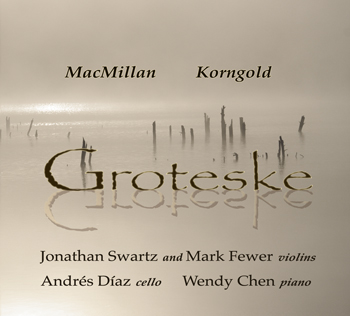Fantasy Variations on a Theme by Charpentier
When Jonathan Swartz commissioned me to write a quartet for two violins, cello, and piano " stipulating only that it should "feature the two violins equally, my mind immediately went back almost eighteen years, to 1989 and the Interlochen Arts Camp. That summer, I accompanied Jonathan and another violinist in a performance of J.S. Bach's Concerto in D Minor for Two Violins, an experience I've never forgotten.
Although I considered adopting the form of Bach's masterpiece, I ultimately decided to write a theme and variations. It didn't take long to choose the perfect subject: Marc-Antoine Charpentier's exquisite Ritournelle from his cantata, In Nativitatem D.N.J.C. Canticum, a movement I've always greatly admired.
The piece first presents Charpentier's theme in its original form, then freely varies the material in a set of eleven variations, concluding with a rondo-scherzo that further develops and recapitulates all of the music. The variations are grouped in a three-part arch structure (4-3-4), each part separated by a cadential break, while the variations within each part flow smoothly, one into the next. Like a "Fantasy," the variations continuously reconsider Charpentier's theme, often discovering worlds unrecognizable from its baroque origins: Variation I turns the opening violin melody into a short rocking gesture that later evolves into an impressionistic cascade; Variation II gives prominence to a cello gesture taken from the middle of the theme; Variation III develops one of Charpentier's short canonic subjects into a pizzicato string accompaniment while the piano adds a rolled-chord melody drawn from a completely different part of the theme; and so on. The only clear unifying factor is that each variation borrows the ritournelle form of the original, with the two violins regularly switching parts to maintain equality and balance.
These Variations clearly reveal my eclectic musical influences: you're bound to hear Ravel, Prokofiev, Morricone, Mozart, Reich, Barber, Messaien, Adams, Sondheim, Harbison, Tchaikovsky, Saint-SaíŽns, and even the Funk Brothers. Of course, you'll also hear Bach - in perhaps the clearest and shortest homage - and Charpentier, from whose brilliant gem this whole piece emerged.
- Kieren MacMillan
Suite Opus 23, for 2 violins, cello, and piano
A child prodigy named partly in homage to Wolfgang Amadeus Mozart, it is fitting that Erich Wolfgang Korngold found fame in Hollywood. Hailed as one of the great film composers of all time, the young Korngold - like Mozart - demonstrated a knack for musical drama through opera. Korngold's relocation to America because of the Nazi regime, along with the advent of the film industry, led to the symbiotic match that is ultimately responsible for his recognition today.
While Hollywood made the world aware of this brilliant composer, others trumpeted his gifts all along. Gustav Mahler declared Korngold a "genius," and stories abound similar to Mozart of Korngold's compositional prowess, unparalleled ear and memory, and unique creativity. Many of Korngold's non-film compositions were rediscovered and explored upon his fame, uncovering the work of one of the most gifted classical composers of all time.
Suite Op. 23 is one of Korngold's masterworks that has yet to receive its deserved acclaim. Commissioned in 1928 by pianist Paul Wittgenstein - who had lost his right arm during World War I - and completed in 1930, Op. 23 is a tour de force for the piano. It explores a range of sounds and virtuosity hardly imagined possible using only one hand. Korngold's compositional genius here extends beyond musical creativity, using arpeggiations, rolled chords, and grace notes in the piano - musically reminiscent of a Mahler symphony - to create an expansive range within its practical limitations.
Korngold relies on traditional forms in this composition, despite the innovative sounds. The opening movement is a Prelude and Fugue, with roots hearkening back to Bach while seemingly overturning the earth from which they emanate. The second movement is a charming Waltz, transporting the listener back to Korngold's hometown, Vienna. The third movement, Groteske, is a whirling Scherzo interrupted by a longing Trio, with a combined magnetic musical force, making it the title track of this recording. The fourth movement is a tender song - "Was Du mir bist?" (What You Are to Me) from Korngold's own Op. 22 - that counters the previous movement's grotesque with the sublime. And the final movement is a set of variations, encompassing the entire work from simple to profound, while celebratory throughout.
- Jonathan Swartz
When Jonathan Swartz commissioned me to write a quartet for two violins, cello, and piano " stipulating only that it should "feature the two violins equally, my mind immediately went back almost eighteen years, to 1989 and the Interlochen Arts Camp. That summer, I accompanied Jonathan and another violinist in a performance of J.S. Bach's Concerto in D Minor for Two Violins, an experience I've never forgotten.
Although I considered adopting the form of Bach's masterpiece, I ultimately decided to write a theme and variations. It didn't take long to choose the perfect subject: Marc-Antoine Charpentier's exquisite Ritournelle from his cantata, In Nativitatem D.N.J.C. Canticum, a movement I've always greatly admired.
The piece first presents Charpentier's theme in its original form, then freely varies the material in a set of eleven variations, concluding with a rondo-scherzo that further develops and recapitulates all of the music. The variations are grouped in a three-part arch structure (4-3-4), each part separated by a cadential break, while the variations within each part flow smoothly, one into the next. Like a "Fantasy," the variations continuously reconsider Charpentier's theme, often discovering worlds unrecognizable from its baroque origins: Variation I turns the opening violin melody into a short rocking gesture that later evolves into an impressionistic cascade; Variation II gives prominence to a cello gesture taken from the middle of the theme; Variation III develops one of Charpentier's short canonic subjects into a pizzicato string accompaniment while the piano adds a rolled-chord melody drawn from a completely different part of the theme; and so on. The only clear unifying factor is that each variation borrows the ritournelle form of the original, with the two violins regularly switching parts to maintain equality and balance.
These Variations clearly reveal my eclectic musical influences: you're bound to hear Ravel, Prokofiev, Morricone, Mozart, Reich, Barber, Messaien, Adams, Sondheim, Harbison, Tchaikovsky, Saint-SaíŽns, and even the Funk Brothers. Of course, you'll also hear Bach - in perhaps the clearest and shortest homage - and Charpentier, from whose brilliant gem this whole piece emerged.
- Kieren MacMillan
Suite Opus 23, for 2 violins, cello, and piano
A child prodigy named partly in homage to Wolfgang Amadeus Mozart, it is fitting that Erich Wolfgang Korngold found fame in Hollywood. Hailed as one of the great film composers of all time, the young Korngold - like Mozart - demonstrated a knack for musical drama through opera. Korngold's relocation to America because of the Nazi regime, along with the advent of the film industry, led to the symbiotic match that is ultimately responsible for his recognition today.
While Hollywood made the world aware of this brilliant composer, others trumpeted his gifts all along. Gustav Mahler declared Korngold a "genius," and stories abound similar to Mozart of Korngold's compositional prowess, unparalleled ear and memory, and unique creativity. Many of Korngold's non-film compositions were rediscovered and explored upon his fame, uncovering the work of one of the most gifted classical composers of all time.
Suite Op. 23 is one of Korngold's masterworks that has yet to receive its deserved acclaim. Commissioned in 1928 by pianist Paul Wittgenstein - who had lost his right arm during World War I - and completed in 1930, Op. 23 is a tour de force for the piano. It explores a range of sounds and virtuosity hardly imagined possible using only one hand. Korngold's compositional genius here extends beyond musical creativity, using arpeggiations, rolled chords, and grace notes in the piano - musically reminiscent of a Mahler symphony - to create an expansive range within its practical limitations.
Korngold relies on traditional forms in this composition, despite the innovative sounds. The opening movement is a Prelude and Fugue, with roots hearkening back to Bach while seemingly overturning the earth from which they emanate. The second movement is a charming Waltz, transporting the listener back to Korngold's hometown, Vienna. The third movement, Groteske, is a whirling Scherzo interrupted by a longing Trio, with a combined magnetic musical force, making it the title track of this recording. The fourth movement is a tender song - "Was Du mir bist?" (What You Are to Me) from Korngold's own Op. 22 - that counters the previous movement's grotesque with the sublime. And the final movement is a set of variations, encompassing the entire work from simple to profound, while celebratory throughout.
- Jonathan Swartz




